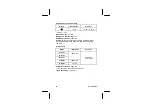
29
M731400M00
True RMS technical :
The true RMS technique multimeter use the RMS mathematic
operation procedures in the electric circuit to obtain the true
RMS value.
So
the
true RMS measurement is independent
of the wave form of the signal under test normally.
The applications for true RMS measurement, for example, is the
measurement of the energy content of SCR waveforms at
differing firing angles and measurement of noise and meas-
urement of distorted waveforms with the presence of harmon-
ics. The harmonics in the main circuit may cause circuit break-
ers to trip prematurely and transformers to overheat motors to
burn out, fuses to blow faster than normal and BUS bars and
electrical panels to vibrate, and neutrals of three phase system
to overheat.
AC / AC+DC coupling true RMS :
AC coupling true RMS :
Measures the energy of the AC
component only in a signal. For example, measures the noise
energy on a DC signal.
AC+DC coupling true RMS :
Measures the total energy in
a signal. For example, measures the dissipative energy on a
SCR thyristor used to control the brightness of a bulb.
A voltage signal with AC component and DC component can
be expressed as :
V
RMS (AC+DC)
= V
2
RMS (AC)
+ V
2
DC
Crest Factor :
The definition of Crest Factor (CF)
:
CF = V
PEAK
/ V
RMS
A wave form with higher order harmonics has a big CF value.
Normally the CF value implies the ability of a true RMS
multimeter to test the sharp wave form or distorted wave form.




































